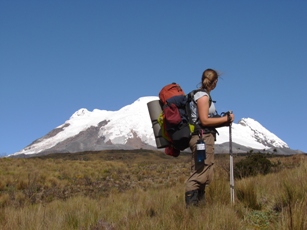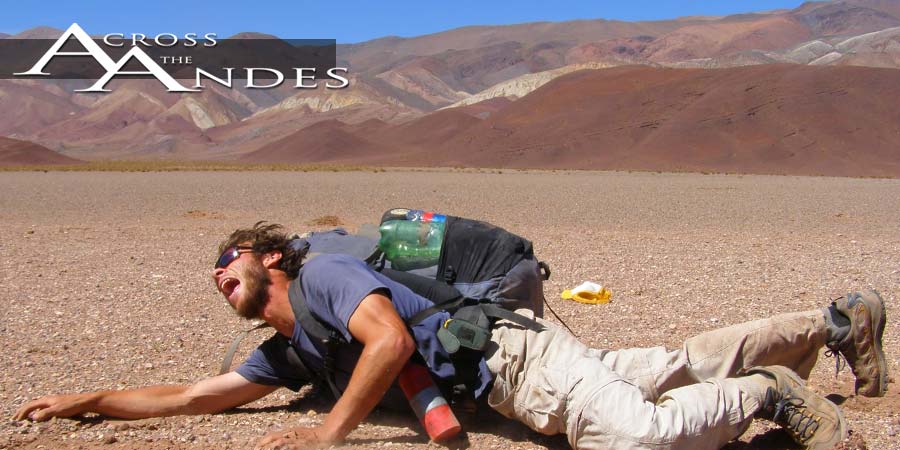Here We Go
By Gregg Treinish
July 13, 2006

We are currently in Latacunga, and I don´t quite know where to begin summarizing the last several days. These mountains are more than incredible. For eight days, Deia and I saw less than ten people, we saw maybe four roads (all dirt and completely untraveled) and experienced a land untouched, untainted by anything and anyone. Never in our wildest dreams could we ever imagine landscapes so vast, and so incredible as we now can. The hiking is more challenging and more rewarding than either of us have ever experienced and our first hike has truly lived up to every daydream and every thought that we have shared.
As we left Quito, we had little idea what to expect. When we stepped into the unknown in Papallacta, and the bus pulled away, the feeling of being out there truly sank in. In a town with less than 200 inhabitants, we were now in the middle of nowhere and ¨where are we?¨ quickly became the quote of the week. We spent the night near some aguas thermales and began our hike the next morning. After a little detour into extremely dense vegetation that left us both covered in hives, we finally made our way to El Tambo and took our first steps towards the south. The feeling of those first steps, the anticipation of what is to come combined with the accomplishment of actually getting to a place we have both dreamed of for a long long time was truly extraordinary. It may have been possible to enjoy that feeling for awhile too, if the path we were following at the moment wasn´t comprised entirely of mud that sucked us in, often to our knees. They call the section of the Appalachian Trail in Vermont, Vermud ; Vermud was nothing. At 12,000 feet, this quickly became the most difficult hiking we have ever encountered. We made our way a mere 6 miles or so from our starting point in Papallacta and camped on the first ridge that was somewhat flat that we could find. We had been hiking in the dark with no trail, no water, no idea where the lake we where supposed to be at was, and no idea what the giant shadow across the valley could possibly be looming high overhead (no mountain could possibly be that big).
Awaking the next morning with the rising sun, we found ourselves in a setting unlike any that either of us had ever seen. The paramo was exactly how it would have been thousands of years ago, Mountains that easily doubled the size of the Rockies we are so used to waking up to, were all around and the vastness of the land quickly became evident. We hiked on, finding our lake and ascending to 14,500 feet to cross the saddle between Volcan Antisana and an unnamed peak to the west. As the sun began to set, the feral horses, rare antelope called pudu, and the feral bulls checked out the strangers walking through their pastures, and we descended to the valley below Antisana. It was here that we´d spend the next three nights as Deia became ill with what was probably the flu and a bit of altitude sickness.
Hiking on, a bit lower on food, and having met the sheep herders
that for a few days crossed our path every morning and late afternoon,
it was on to Sincholagua, the vast steep mountain with cliff bans that
appeared greater than 90 degrees and rocky crags we knew our friends in
Leadville would be drooling over. Throughout the day and most of the
hike so far, trails have been scattered at best. There are often cow
paths that we can follow, but they are far too muddy to make it any
easier. The altitude is hard to climb with, but we are managing well
and pushing each other to get to our destinations. At this point we
have mostly taken to the ¨lets go there¨ type of navigation; it has
proved most effective. The mountains are so recognizable and so big
that simply aiming for one side of a mountain is often the best way to
go.
Perhaps the most recognizable and most spectacular of all the mountains
we have seen so far is Cotopaxi. When we crossed the final ridge
blocking the view of what we have endearingly termed ¨The Pax,¨ tears
were not far behind. 22km across, rising to 19,800 feet (almost 6,000
ft above us), and perfectly cone shaped, The Pax is truly one of the
most awesome sights on this planet. The amazement at the mighty giant
soon evaporated all of the mud, all of the elevation, all of the pain,
and all of the difficulty. We may as well have been walking on clouds
(which incidentally we were). As we descended the valley towards the
eastern slopes and the Hacienda Mudadero, the reality of how lucky we
really are was not at all far from the surface. We spent a good while
learning about the alpacas that are kept at the Hacienda and how they
along with the wokers had been discarded because of a lack of profit.
Having essentially been left to die, the national bank of Ecuador had
saved the ranch and it was beginning to get back up and running. We
watched the old and sick Alpaca being put out to pasture and the young
and healthy ones kept for their wool. We offered to stay and work, but
the poverty that is part of their lives left the group of six or so
workers unable to pay us, even with just food. Running out of food
ourselves, there was no choice but to hike on around Cotopaxi.
Through valleys strewn with volcanic shrapnel in the form of giant boulders, through rain, 50 plus mph winds, and through more untouched terrain, we walked, all the time with The Pax watching over us to our right, and all the time amazed at the landscapes. We did a few bigger days and finally made our way to Mualó, a tiny town over 4,000 ft below where we had spent the previous night, having successfully completed the first of a lot of sections of this vast vast continent. We are both sore and both very respectful of the Andes. Our plan is to summit The Pax tomorrow or the next day. For now we are resting in Latacunga and will keep you updated as to our next section. We miss all of you at home and look forward to reading emails from you all.







